We have a dinnertime conversation starter we use each night with the kids. We call it our “High/Low Questions.” We go around the table with each person answering a few questions about their day. The first two are always the same.
- What was your high today? – What brought you joy, a sense of accomplishment, satisfaction, or happiness?
- What was your low today? – What was disappointing, sad, or frustrating?
We usually mix up the last question. Sometimes we’ll ask, “what did you learn today” or “how did you help someone today” or even “what are you looking forward to tomorrow?” We enjoy the activity because it helps the kids process through emotions and tough times and gives us an opportunity to understand what everyone is going through and how we can help.
In our city lives, the game helped us understand each others’ challenges and shed light on certain issues. For a long stretch our oldest child’s “low” everyday was “going to school.” Conversations around the topic helped us better understand some of his challenges and how we could help. I had days when someone would ask me for my “high” and I would sit there for several seconds before finally saying, “I don’t think I had a high today, it was just another day at work.” Other times, it’s an opportunity to celebrate each other, like the time our toddler’s high was using the potty for the first time!
So, to answer some of the questions we received about how things are going in our first few weeks on the farm, I’ll follow our family tradition by sharing some of our highs, lows and what we’ve learned.
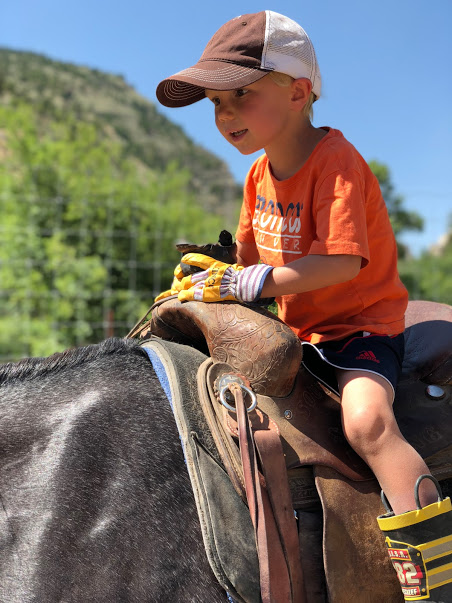
Highs
- The laying hens have a fancy new coop and are thriving. They love the extra space and are more productive and healthy than ever before.
- The bees survived the move and started reproducing rapidly.
- We got a bunch of baby chicks! And, they are just as cute and fuzzy as you would expect.
- Everything fit in our loft bedroom space and it is really cozy and comfortable.
- Our yak Tashi had a calf! You haven’t seen cute until you’ve seen a baby yak.
- Our tomatoes are flowering and looking awesome. Many of the crops we direct seeded have also sprouted. The radishes, spinach and red russian kale are taking off.
- Several of the raspberry, blueberry and fruit tree starts we planted over spring break survived.
- Wildflowers make great bouquets.
- Mid-afternoon cool downs in the creek.
- Our potager garden looks “beautiful, peaceful and relaxing.”
- The kids are so excited and have gained a lot of confidence.
- Our first visitor from Denver.
- We’re getting to know some local ranchers and they baptized us to the cowboy life by sharing some rocky mountain oysters during branding.
- Making lots of sourdough bread and getting our kombucha brew back in gear.
- Watching a family of moose walk by.
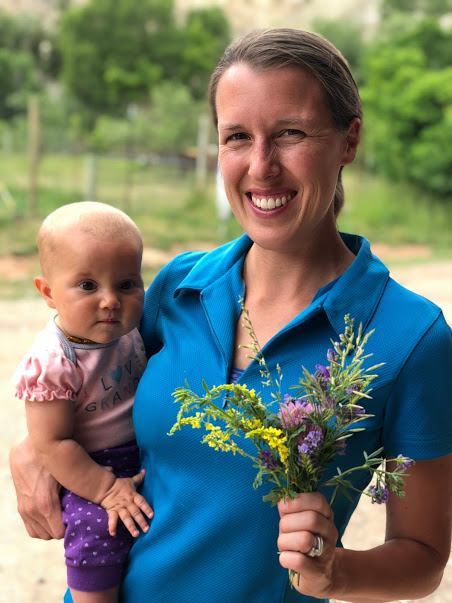
Lows
- Putting a dent in the new coop.
- Losing half of the bees when they swarmed.
- Having several chicks die.
- Jackson (the dog) stepping in the kombucha jar.
- Our fancy seeder not distributing seeds as evenly or consistently as expected.
- Weeds.
- Wicked hay fever exacerbations.
- The yaks chewed on or smashed the blueberry and raspberry starts.
- Getting run over by Smokey the bull yak.
- Kids throwing up on almost every trip to town.
- Hitting our head on everything in the cabin as we adjust to a new space.
- Bug bites, bumps, scratches, sunburns, and dry/cracking hands.
- A really clogged toilet.
- An automatic chicken coop door that still doesn’t work.
- Seeing lots of rodents…and snakes.
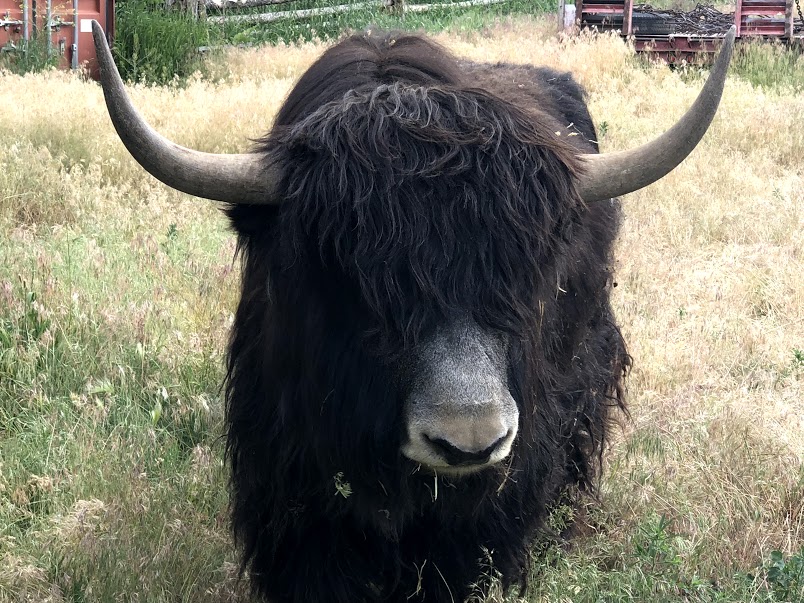
What we've learned
The thing about living on a farm is the highs and lows come rapid fire. We have not had a day in which we couldn’t come up with some tremendous highs, and devastating lows. The beautiful part about all of it is how much we are learning through the process. Here are a few of the key lessons we’ve picked up so far, with some nice anecdotes added for context.
Never trust a bull – Yaks (Bos grunniens) are interesting creatures. They are bovines, same genus as your everyday cow, but they sometimes appear and act less like a cow and more like their distant cousin, the bison. But there is one truth across all cow-like creatures…never trust a bull, and here’s how I learned that lesson.
You see, our yaks have free range over a few designated spaces and have received once-a-week-or-so human interaction over the past few years, so one of the first things I wanted to do was engage with them on a daily basis and exert a little more control over their movement. Our orchard is close to the cabin and the pasture grass was growing in thick under the trees, so I went out one morning and patiently herded our handful of yaks from their upper pasture to the orchard. I was admittedly a bit proud of how well the whole process went, and thought, “look at that, the yaks are already learning to respect me a little.”
Over the next week, we spent a lot of time with the yaks, we gave the kids opportunities to engage with them, and I intentionally went into the orchard and walked around them frequently to build familiarity. On the whole, things seemed to be going great. Some of the younger yaks were friendly and wanted to be petted or hand-fed treats, and the older, more skittish yaks even seemed comfortable with the consistent human contact.
Then came the fateful day I decided to move the herd again. The yaks had mowed through much of the orchard and they were getting a little destructive with their tendency of laying on the raspberry bushes. Not only that, but I had picked up some electric fencing and was anxious to get the yaks onto a designated paddock where I intend to start some rotational grazing patterns with the broiler hens. My first move went so smoothly, and I thought this one would be a breeze. I even had Emily and the kids there to help make sure the yaks turned toward the pasture and not into the garden. I called the yaks and enticed them with a few treats to get the herd moving, and everything seemed to be going swimmingly until I got up to the next pasture and realized Smokey the bull was not with the girls. I locked the female yaks in the pasture, knowing they would probably follow me back without Smokey there, and walked back to the orchard.
Emily was in the orchard and said Smokey had been laying in the shade and with the injured foot he’s been fighting, he didn’t get moving as quickly as the others. She had tried to encourage him along, but he wouldn’t move toward the gate. Whip in hand to help guide the herds’ movement, I told Emily to stay put and just make sure he turned toward the pasture and not into the garden. I walked around Smokey, keeping my distance, and positioning myself such that Smokey was between me and the gate, I gave a few cracks of the whip and whooped a little to get him to move. Unlike a week earlier when Smokey appropriately shuffled away from me when I did the same thing, Smokey instead took a few steps toward me. Undeterred, I gave another whoop, and watched as Smokey took a few more steps toward me and then picked up to a full sprint. Knowing full well the last thing you should do with any domestic animal is back down to their threat, I stood my ground. Yaks have a tendency to “bluff charge” and I had been bluffed by the older yaks on several occasions. I knew the best way to break the bluff charge habit was to not stand for it and not back down to it.
I had a problem though, Smokey started his charge from several feet further away than any of the bluff charges I’ve experienced, and he sure as heck did not appear to be bluffing. That brief thought became reality in less than a second as Smokey put his big left horn under my arm, his head square into my chest and proceeded to attempt running through me. I try diligently to watch my language around the kids, but as Smokey’s head hit my chest I blurted out “Smokey you &@$#*!” Some how, some way, I bounced off him in such a way I landed on my feet. The first thought that came to my head was “great, now I’m going to be sore for weeks,” but I kept my wits about me just enough to crack the whip a few times and chase Smokey out of the orchard. Emily had wisely sought safety, which meant Smokey of course turned toward the garden, before thinking better of it and running up toward the rest of the herd.
Thankfully, my injuries did not necessitate a hospital visit. When I shared the story with my dad he said, “He didn’t even knock you off your feet, he must not have gotten you too good,” but he got me good enough. There are still plenty of ribs that are sore besides my ego. The story traveled well across the local network of ranchers who shared the all important words of wisdom, never trust a bull!
Smokey and I have made amends. Just a few days after the whole debacle he was back eating treats out of my hand. I still like Smokey and I hope his foot heals up so he can continue being a productive bull, but one thing is for sure, I’ll never trust him again…or any other bull for that matter.
Do trust your gut – Emily and I have read a lot in recent months in preparation for this journey. Whether it be books on gardening, beekeeping, chickens, or cooking, we’ve been educating ourselves on the skills we’ll need to successfully run a farm. Even so, we’ve had several occasions in which questions arise for which there is not an answer in one of our books, or the answer doesn’t fit our context. Ultimately it points to the cold hard fact that Joel Salatin likes to point out, “You can’t google experience.”
One such situation developed with our bees over the past week and half. Since we arrived, the bees have been loving the abundant nectar and pollen supply, and I noticed early on their population seemed to be growing rapidly. I opened up some more space in the back of the hive, but for two inspections in a row they seemed to be cramped at the front without making much progress toward the back. During my last inspection I thought to myself, “I wonder if I need to add more bars to the front.” But, the next thought that came to me was, “I don’t know, I don’t want to agitate them and they have plenty of space in the back, they need to start moving that way. I think I’ll just wait a week and see what they do.”
What did they do? They swarmed. Of course they swarmed! I tried feebly for a few hours to chase the swarm up the creek with a bottle of lemongrass oil and a box, but my efforts were in vain. The queen was fed up with a cramped entrance to her hive and she had rallied half the workers and taken off to find a bigger space. I had resolved to add more space at the front of the hive during my next inspection, which was the following day. As the swarm moved further and further up the creek, Emily and I discussed the situation and came to the conclusion that every time we say about anything related to the garden or animals “let’s just wait and see what they do” we instead need to drop whatever we are doing and take immediate action.
As far as the bees are concerned, it’s a bummer to lose our first queen, but it doesn’t mean our beekeeping ventures are over. The queen left behind several thousand bees (more than we started out with in Denver) and they already have several “queen cups” developed. This colony will rear a new queen and continue on in their work, but it sure would have been nice to manage the divide ourselves so we could have two hives instead of one.
Baby animals die when they get wet at night – Our context for this lesson relates to the previous topic of trusting our gut. In one instance I trusted my gut, and in the second I did not. The outcomes were accordingly fine and disastrous. The first came with our baby yak, Ember. During her first day of life she was pushed around a little by a few of the other yaks in the herd. Out of concern for her safety we moved her and her mother into a space where they could be isolated from the rest of the herd.
That night, it started to rain, and we immediately grew concerned about the fact that the calf did not have any shelter in the area we had confined her. So in the pitch dark I went out with a floodlight to run the rest of the herd in the trees and adjust some fencing so Tashi and Ember had access to our manger. Of course, as soon as I finished, the rain stopped, but I slept much better knowing the calf could get under cover and would not be soaked in the middle of the night.
Unfortunately, my judgement was not so prudent just two nights later when I noticed something strange with our baby chicks. The chicks had been doing great for about 5 days, but it seemed like they were going through a lot of water, so we added a larger waterer earlier in the day thinking they were just consuming a lot. Throughout the evening I noticed it seemed like the chicks were getting wet, but I couldn’t figure out why. The waterer wasn’t leaking and I thought they must have been pushing each other into it when they were trying to eat, so I moved the food further from the water. Before going to bed I took another look at the chicks, and realized they seemed to even more wet, but they were all bunched up under the light. Things didn’t seem entirely right, but I thought, “they’re going through a lot of water, so I don’t want to take it away – at least they’re all under the light, I think I’ll just see how they do tonight and move their waterer again if they keep pushing each other in it.”
This was a dumb decision! Remember what I said about the bees. If something seems a little off, it probably means I should have already taken some kind of action. Waiting to see what happens is never a good idea with animals. I woke up the next morning to find the chicks even more wet than before, and with several of them dead. I let out a litany of f-bombs as I urgently threw together a new, and dry, brooder for the chicks that survived and counted through the dead. There’s no sugar coating this disaster. I screwed up big time, and all because I was hesitant to jump in when something seemed off. You see, the chicks weren’t drinking through all of the water we were giving them, they were wading through it when they bounced around the brooder and the bigger water simply gave them a bigger wading pool. Because they were wet, the chicks would then jump on top of each other to get under the light – in the process dripping water onto all of the chicks below. As the process progressed over a period of hours the chicks got more wet. As they got more wet, they got more cold. As they got cold they jumped on top of more chicks to get under the light, thereby getting the other chicks more wet, and cold. You see where this is going…
Emily’s emergency research helped us understand a few of the ways we set the chicks up for this disaster and a few minor adjustments to the brooder resolved the issue and helped the remaining chicks to recover (placing the water on a block so they can’t step in it, more absorbent bedding, and a heat lamp with a wider cone of light). Thankfully after a few days, we’re back on track with a lively and healthy looking collection of chicks plowing through food and drinking their water, rather than swimming in it.
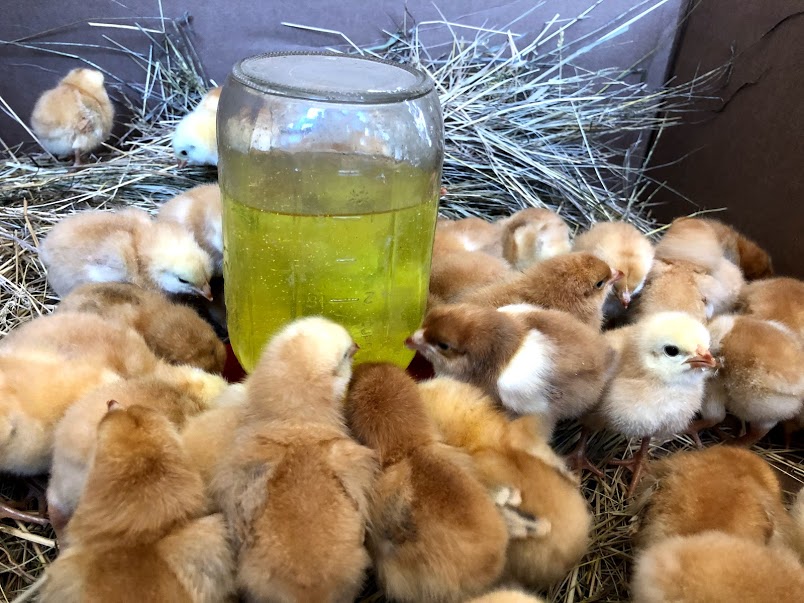
The most important lesson
Through it all, the most important lesson we’re learning is how to deal with the highs and lows of life gracefully, and the kids are some of our best teachers. Even in the face of failure, the kids have been undeterred in their excitement, commitment and desire to learn more about our animals. The English poet William Wordsworth put it best in his poem The Tables Turned saying, “Come now, into the light of things, let nature be your teacher. She has a world of ready wealth, our minds and hearts to bless – spontaneous wisdom breathed by health, truth breathed by cheerfulness.”
Let it be so here.
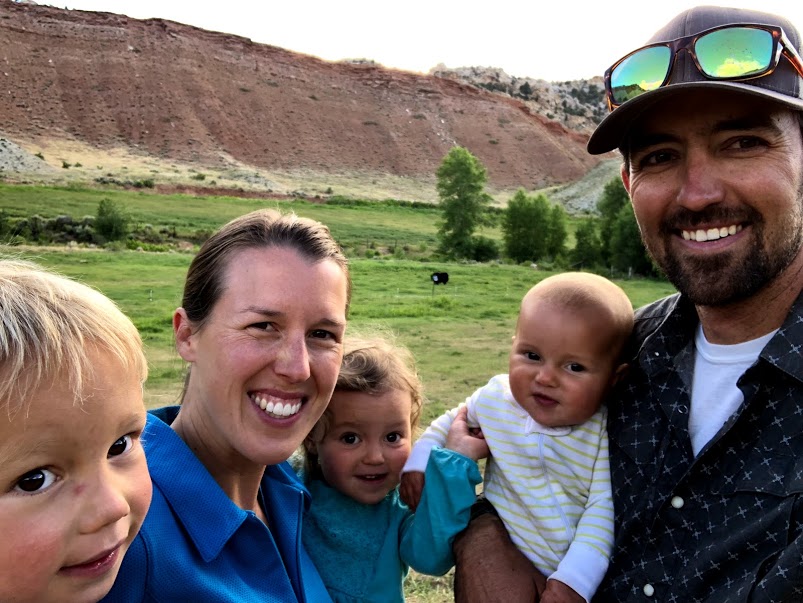

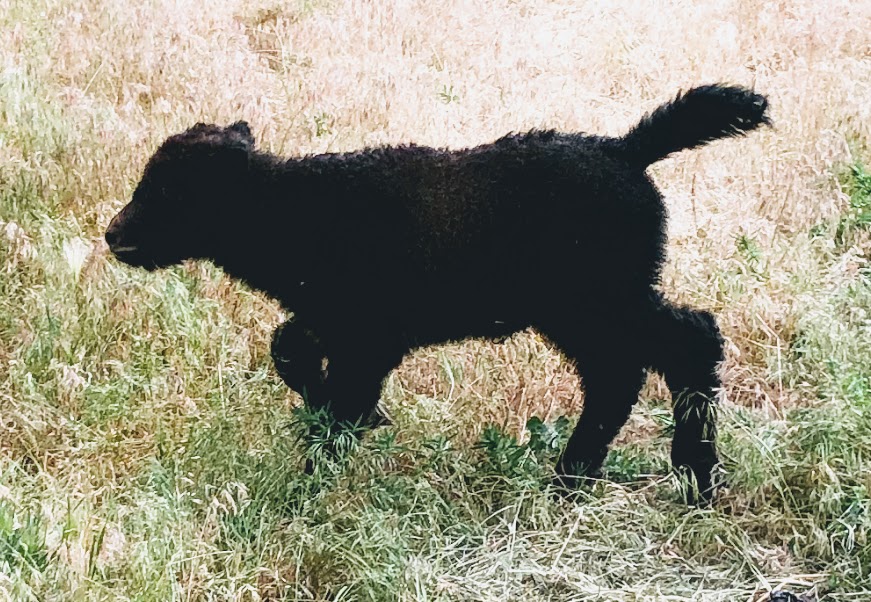
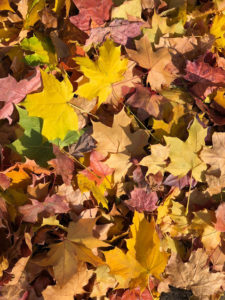


Steve and Emily and kiddos,
How wonderful to read about your adventures in your new home! So much work, but tons of joy, as well!
The photos are super and the narrative the best!
You are missed but close by at the touch on the keyboard!
Doug and Gwen
Thanks Doug and Gwen. It’s been quite the adventure so far and the time is flying by! We look forward to seeing everyone again next time we’re in Denver.
Wow what an experience you have had. Sounds like you are learning a ton by trial and error but glad things seem more on track. Tons of respect to the two of you. We would love to come visit!
Julie
We are definitely learning a lot every day! We would love to have you come visit any time!